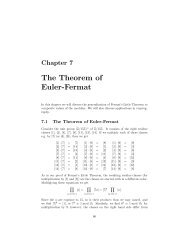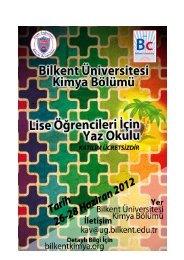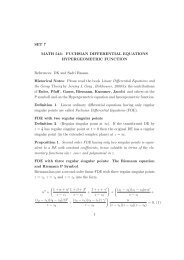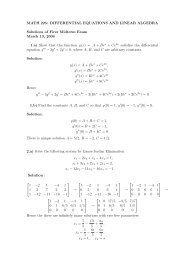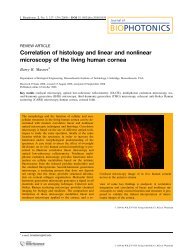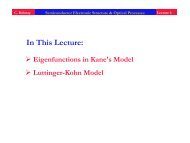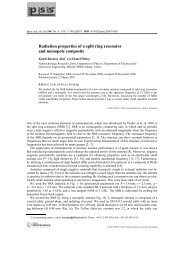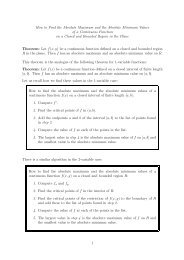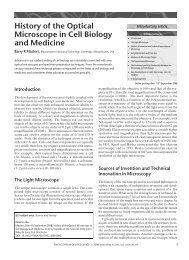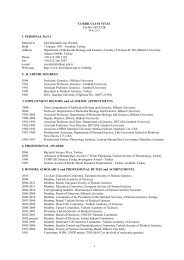Introduction to the English Edition of Hilbert's Zahlbericht
Introduction to the English Edition of Hilbert's Zahlbericht
Introduction to the English Edition of Hilbert's Zahlbericht
You also want an ePaper? Increase the reach of your titles
YUMPU automatically turns print PDFs into web optimized ePapers that Google loves.
A special feature <strong>of</strong> Hilbert’s <strong>Zahlbericht</strong> which <strong>the</strong> unsuspecting reader may not be<br />
prepared for is <strong>the</strong> very uneven usage <strong>of</strong> notions from abstract algebra. Thus, while <strong>the</strong><br />
notion <strong>of</strong> fields and <strong>the</strong>ir arithmetic is at <strong>the</strong> very heart <strong>of</strong> Hilbert’s concept <strong>of</strong> algebraic<br />
number <strong>the</strong>ory, and even though Hilbert uses <strong>the</strong> word “(Zahl)ring” for orders in algebraic<br />
number fields, this must not be taken as evidence that Hilbert employs here parts <strong>of</strong> our<br />
current algebraic terminology <strong>the</strong> way we would do it; ra<strong>the</strong>r than referring <strong>to</strong> a general<br />
algebraic structure, 28 <strong>the</strong> word “ring” is used for sets <strong>of</strong> algebraic integers which form<br />
a ring in our modern sense <strong>of</strong> <strong>the</strong> word. Similarly, but much more obviously for <strong>the</strong><br />
modern reader, Hilbert does not have at his disposal general abstract notions from group<br />
<strong>the</strong>ory that could unify <strong>the</strong> discussions <strong>of</strong> situations that we immediately recognize as<br />
analogous. 29 Most striking is <strong>the</strong> absence from <strong>the</strong> <strong>Zahlbericht</strong> <strong>of</strong> <strong>the</strong> notion <strong>of</strong> quotient<br />
groups. 30 Thus, when we would say that “G/H is cyclic <strong>of</strong> order h,” Hilbert has <strong>to</strong> write<br />
elaborate prose: “<strong>the</strong> members <strong>of</strong> G are each obtained precisely once when we multiply<br />
<strong>the</strong> members <strong>of</strong> H by 1, g, . . . , g h−1 where g is a suitably chosen member <strong>of</strong> G”(see e.g.<br />
<strong>Zahlbericht</strong>, Sätze 69, 71 and 75).<br />
Contrary <strong>to</strong> <strong>the</strong>se points, which, from our vantage point, may be considered as shortcomings,<br />
but which <strong>the</strong> <strong>Zahlbericht</strong> shares with most o<strong>the</strong>r texts on <strong>the</strong> subject before<br />
Hecke’s book from 1923, some o<strong>the</strong>r unusual features <strong>of</strong> <strong>the</strong> text have <strong>to</strong> be counted<br />
among its pearls. In fact, <strong>the</strong>orems 89–94 may be regarded as <strong>the</strong> first highlight <strong>of</strong> <strong>the</strong><br />
<strong>Zahlbericht</strong>. Here Hilbert did “point <strong>the</strong> way <strong>to</strong> fur<strong>the</strong>r research.”<br />
Hilbert’s Satz 89 says that <strong>the</strong> ideal class group is generated by <strong>the</strong> classes <strong>of</strong> prime<br />
ideals <strong>of</strong> degree 1. In <strong>the</strong> special case <strong>of</strong> cyclo<strong>to</strong>mic fields, this result is due <strong>to</strong> Kummer. 31<br />
It is a very special case <strong>of</strong> <strong>the</strong> density <strong>the</strong>orems <strong>of</strong> class field <strong>the</strong>ory, such as Chebotarev’s,<br />
but it is accessible without analytic methods. Already Max Deuring 32 remarked that<br />
28 According <strong>to</strong> I. Kleiner, From numbers <strong>to</strong> rings: <strong>the</strong> early his<strong>to</strong>ry <strong>of</strong> ring <strong>the</strong>ory, Elem. Math. 53<br />
(1998), 18–35, <strong>the</strong> modern axiomatic definition <strong>of</strong> a field is due <strong>to</strong> Steinitz (1910), that <strong>of</strong> a ring <strong>to</strong><br />
Fraenkel (1914) and Sono (1917).<br />
29 This omission seems <strong>to</strong> be deliberate: in his letter from 21-7-1896 (loc. cit.), Minkowski suggested<br />
that <strong>the</strong> inclusion <strong>of</strong> a few lemmas on Abelian groups in §100 would allow <strong>the</strong> reader <strong>to</strong> enjoy Hilbert’s<br />
pro<strong>of</strong> <strong>of</strong> <strong>the</strong> <strong>the</strong>orem <strong>of</strong> Kronecker-Weber without distractions [“Damit der Leser zu einem völlig<br />
ungestörten Genusse desselben komme, möchte ich empfehlen, die gebrauchten Hilfssätze über Abelsche<br />
Gruppen mit Andeutungen ihrer Beweise vorweg in §100 zu absolviren.”]<br />
30 Fac<strong>to</strong>r groups were first defined by O. Hölder, Zurückführung einer algebraischen Gleichung auf<br />
eine Kette von Gleichungen, Math. Ann. 34 (1889), 26–56; <strong>the</strong>y are discussed in Weber’s Algebra 2,<br />
Braunschweig 1896, but authors ranging all <strong>the</strong> way from Heinrich Weber himself (Ueber Zahlengruppen<br />
in algebraischen Körpern, Math. Ann. 48 (1897), 433–473) <strong>to</strong> Erich Hecke (Vorlesungen über die Theorie<br />
der algebraischen Zahlen, Leipzig 1923, where Chapters II and III are devoted <strong>to</strong> Abelian groups) found it<br />
necessary <strong>to</strong> explain <strong>to</strong> <strong>the</strong>ir readers <strong>the</strong> concept <strong>of</strong> groups in general, and <strong>of</strong> fac<strong>to</strong>r groups in particular.<br />
— See L. Corry, Modern algebra and <strong>the</strong> rise <strong>of</strong> ma<strong>the</strong>matical structures; Science Networks, vol 17, Basel,<br />
Bos<strong>to</strong>n (Birkhäuser) 1996, in particular Chapter III, for an extensive discussion <strong>of</strong> Hilbert’s position in<br />
<strong>the</strong> development <strong>of</strong> modern abstract algebra.<br />
31 E.E. Kummer, Über die Zerlegung der aus Wurzeln der Einheit gebildeten complexen Zahlen in ihre<br />
Primfak<strong>to</strong>ren, Collected Papers I, 211–251, in particular pp. 241–243.<br />
32 In M. Deuring, Neuer Beweis des Bauerschen Satzes, J. Reine Angew. Math. 173 (1935), 1–4, one<br />
reads in reference <strong>to</strong> Satz 89: “. . . ist eine naturgemäße Verallgemeinerung eines wenig beachteten Satzes<br />
in Hilbert’s <strong>Zahlbericht</strong>.”<br />
9



